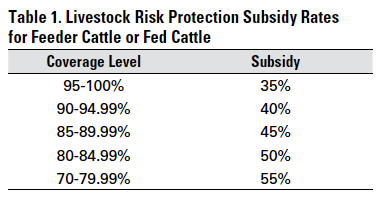Safeguarding Success: Bagley Risk Management Services
Safeguarding Success: Bagley Risk Management Services
Blog Article
Recognizing Animals Threat Protection (LRP) Insurance: A Comprehensive Guide
Browsing the world of livestock risk defense (LRP) insurance can be a complex endeavor for many in the farming industry. From how LRP insurance policy operates to the numerous coverage alternatives readily available, there is much to uncover in this extensive guide that can possibly form the means livestock producers come close to threat monitoring in their companies.

How LRP Insurance Policy Functions
Occasionally, recognizing the mechanics of Animals Threat Protection (LRP) insurance can be complex, yet damaging down exactly how it works can provide quality for breeders and farmers. LRP insurance coverage is a risk monitoring tool made to protect livestock producers versus unforeseen cost decreases. It's essential to keep in mind that LRP insurance policy is not an income warranty; instead, it focuses solely on rate threat security.
Eligibility and Coverage Options

When it comes to coverage alternatives, LRP insurance offers producers the versatility to select the coverage degree, protection duration, and recommendations that finest match their risk monitoring demands. By comprehending the qualification criteria and coverage alternatives readily available, livestock manufacturers can make enlightened choices to manage danger properly.
Benefits And Drawbacks of LRP Insurance Coverage
When evaluating Livestock Danger Defense (LRP) insurance policy, it is necessary for livestock manufacturers to weigh the benefits and drawbacks inherent in this threat administration tool.

One of the key advantages of LRP insurance policy is its capacity to supply defense versus a decrease in livestock rates. Additionally, LRP insurance policy uses a degree of flexibility, enabling manufacturers to tailor protection levels and policy periods to fit their particular needs.
However, there are additionally some disadvantages to consider. One restriction of LRP insurance coverage is that it does not shield versus all kinds of dangers, such as disease episodes or all-natural calamities. Additionally, premiums can occasionally be costly, particularly for manufacturers with large livestock herds. It is crucial for producers to very carefully analyze their individual danger exposure and economic circumstance to identify if LRP insurance policy hop over to here is the appropriate risk management device for their operation.
Recognizing LRP Insurance Policy Premiums

Tips for Making The Most Of LRP Perks
Making best use of the benefits of Livestock Risk Defense (LRP) insurance policy needs critical preparation and proactive threat management - Bagley Risk Management. To make the most of your LRP protection, take into consideration the complying with ideas:
Routinely Evaluate Market Conditions: Keep informed regarding market patterns and rate variations in the livestock sector. By checking these variables, you can make enlightened choices about when to buy LRP coverage to safeguard against prospective losses.
Set Realistic Insurance Coverage Levels: When picking protection degrees, consider your production costs, market worth of animals, and prospective risks - Bagley Risk Management. Establishing practical coverage levels guarantees that you are sufficiently shielded without paying too much for unneeded insurance policy
Expand Your Insurance Coverage: Rather than counting solely on LRP insurance policy, think about expanding your risk monitoring approaches. Combining LRP with other risk management devices such as futures agreements or alternatives can provide detailed protection versus market uncertainties.
Testimonial and Change Protection Regularly: As market conditions change, periodically review your LRP protection to ensure it lines up with your current threat direct exposure. Changing insurance coverage degrees and timing of acquisitions can aid enhance your risk protection strategy. By complying with these suggestions, you can take full advantage of the benefits of LRP insurance coverage and safeguard your livestock operation versus unforeseen risks.
Final Thought
Finally, animals risk protection (LRP) insurance is an important tool for farmers to take care of the monetary threats linked with their livestock operations. By recognizing exactly how LRP functions, qualification and coverage alternatives, in addition to the pros and cons of this insurance coverage, farmers can make enlightened visit choices to protect their source of incomes. By thoroughly thinking about LRP costs and executing approaches to make the most of benefits, farmers can mitigate potential losses and ensure the sustainability of their operations.
Animals manufacturers interested in acquiring Animals Risk Defense (LRP) insurance coverage can explore an array of qualification requirements and coverage alternatives tailored to their specific livestock procedures.When it comes to insurance his response coverage options, LRP insurance offers manufacturers the flexibility to pick the protection level, protection duration, and recommendations that finest suit their risk administration requirements.To comprehend the intricacies of Livestock Threat Security (LRP) insurance policy completely, comprehending the variables influencing LRP insurance costs is important. LRP insurance costs are identified by various elements, including the coverage degree selected, the anticipated rate of animals at the end of the insurance coverage duration, the type of animals being guaranteed, and the size of the protection period.Evaluation and Readjust Coverage Frequently: As market problems change, occasionally assess your LRP insurance coverage to ensure it straightens with your current risk direct exposure.
Report this page